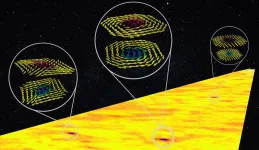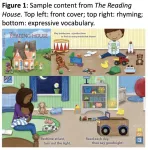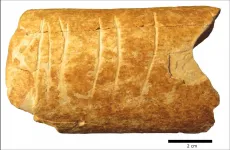Researchers from NUS create 'whirling' nano-structures in anti-ferromagnets
2021-02-04
(Press-News.org) Today's digital world generates vast amounts of data every second. Hence, there is a need for memory chips that can store more data in less space, as well as the ability to read and write that data faster while using less energy.
Researchers from the National University of Singapore (NUS), working with collaborators from the University of Oxford, Diamond Light Source (the United Kingdom's national synchrotron science facility) and University of Wisconsin Madison, have now developed an ultra-thin material with unique properties that could eventually achieve some of these goals. Their results were first published online in the journal Nature on 4 February 2021.
Storing data in anti-ferromagnets
In existing ferromagnet memory devices like hard drives, information is stored into specific patterns of atoms (called bits), within which all the little magnetic poles are oriented in the same direction. This arrangement makes them slow and susceptible to damage by stray magnetic fields. In contrast, a special class of materials called anti-ferromagnets, made up with magnetic poles on adjacent atoms aligned oppositely, are emerging to be important for future memory technology.
In particular, there is a lot of interest in creating special magnetic nano-patterns in anti-ferromagnets that are shaped as whirls or vortices. In essence, each pattern consists of many little magnetic poles winding around a central core region in a clockwise or anti-clockwise manner, very much like air circulating inside a tornado or whirlwind. When realised experimentally, combinations of these anti-ferromagnetic whirls would be quite useful, as they are very stable structures and can potentially be moved along magnetic 'race tracks' at whirlwind speeds of a few kilometres per second!
They could act as new types of information bits that not only store memory but also participate in computational operations. Hence, they would enable a new generation of chips that are significantly faster yet more energy efficient than today's devices.
Experimental discovery of whirls
To date, constructing and manipulating patterns in anti-ferromagnetic materials has been very challenging, as they appear almost non-magnetic from afar. "Standard approaches for control, such as using external fields, fail to work on these materials. Therefore, to realise these elusive anti-ferromagnetic whirls, we came up with a novel strategy that combined high-quality film synthesis from materials engineering, phase transitions from physics and topology from mathematics," explained Dr Hariom Jani, who is the lead author of the paper and a Research Fellow from the NUS Department of Physics.
To grow these materials the researchers fired a laser at an extremely common and cheap material - iron-oxide, which is the main component of rust. By using ultra-short pulses of laser, they created a hot vapour of atomic particles that formed a thin film of iron-oxide on a surface.
Professor Thirumalai Venky Venkatesan, who led the NUS group and invented the pulsed laser deposition process for making the thin film, highlighted the versatility of the team's approach. "The deposition process allows precise atom-level control during the growth, which is important for making high-quality materials. Our work points to a large class of anti-ferromagnetic material systems, containing phase transitions, in which one can study the formation and control of these whirls for eventual technological applications," he said.
Explaining the underlying mechanism, Professor Paolo Radaelli, leader of the Oxford group, shared, "We drew inspiration from a celebrated idea in cosmological physics, from nearly 50 years ago, which proposed that a phase transition in the early universe, during the expansion after the Big Bang, may have resulted in the formation of cosmic whirls. Accordingly, we investigated an analogous magnetic process occurring in high-quality iron-oxide, which allowed us to create at will a large family of anti-ferromagnetic whirls."
The team's next step is to construct innovative circuits that can electrically control the whirls.
INFORMATION:
[Attachments] See images for this press release:

ELSE PRESS RELEASES FROM THIS DATE:
2021-02-04
A study published in the journal Pediatrics expands validation evidence for a new screening tool that directly engages preschool-age children during clinic visits to assess their early literacy skills. The tool, which is the first of its kind, has the potential to identify reading difficulties as early as possible, target interventions and empower families to help their child at home, according to researchers at Cincinnati Children's Hospital Medical Center.
The Reading House (TRH) is an assessment for ages 3-5 based on a specially designed children's book, which was developed by John Hutton, MD, and his team at Cincinnati Children's. Screening takes five minutes and gauges performance levels ...
2021-02-04
An inexpensive, long-lasting and easy-to-administer vaccine against malaria could be a game-changer for millions of people living in countries where the mosquito-borne disease is endemic.
Lucie Jelinkova, a graduate student in the laboratory of Bryce Chackerian, PhD, professor in The University of New Mexico Department of Molecular Genetics & Microbiology, has identified a method that could make that dream into reality.
In research recently published in the journal NPJ Vaccines, Jelinkova and colleagues at Johns Hopkins and Flinders University in Australia report ...
2021-02-04
Tuberous sclerosis complex (TSC) afflicts as many as two million people around the world, affecting multiple organs, including lungs, brain, skin and kidneys. In about 80 percent of cases, it causes cysts and benign tumors to form in the kidney, eventually resulting in kidney failure.
It's known that the disease is triggered by genetic mutations, but how these mutations lead to the formation of kidney cysts has been poorly understood - until now.
Nephrologist Manoocher Soleimani, MD, a professor in The University of New Mexico Department of Internal Medicine, led a team that solved the puzzle and pointed the way toward potential ...
2021-02-04
Twitter has long provided a short, sharp take on the community's fears, anxieties and experiences. Now, data scientists have analysed 94 million tweets from the first months of the pandemic to track COVID-19's effect on mental health in NSW.
The research team used machine learning to develop a model able to capture data indicating depression, stress, anxiety and suicidal thoughts among users of the social media platform.
The aim was to tap into popular technology to help public health experts identify changes in community levels of depression over time.
The World Health Organisation highlighted early in 2020 that the pandemic would likely have a negative impact on mental health, with the disease affecting many facets of life including work, health and relationships.
Researchers from ...
2021-02-04
Senescent cells accumulate in organs during aging, promote tissue dysfunction, and cause numerous aging-related diseases like cancer. The cells arise through a process called "cellular senescence," a permanent cell cycle arrest resulting from multiple stresses.
A collaborative research group led by Professor Makoto Nakanishi of the Institute of Medical Science, The University of Tokyo (IMSUT), and co-researchers has identified an inhibitor of the glutamate metabolic enzyme GLS1(*1) so that its administration selectively eliminates senescent cells in vivo. They confirmed that the GLS1 inhibitor eliminated senescent cells from various organs and tissues in aged mice, ameliorating age-associated tissue dysfunction and the symptoms of obese diabetes, arteriosclerosis, and ...
2021-02-04
While scientists and historians have long surmised that etchings on stones and bones have been used as a form of symbolism dating back as early as the Middle Paleolithic period (250,000-45,000 BCE), findings to support that theory are extremely rare.
A recent discovery by archeologists from the Hebrew University and the University of Haifa alongside a team from the Le Centre National de la Recherche Scientifique in France have uncovered evidence of what may be the earliest-known use of symbols. The symbols were found on a bone fragment in the Ramle region in central ...
2021-02-04
A City of Hope-led research team found that the same gene that increases the risk for Alzheimer's disease, ApoE4, can increase the susceptibility to and severity of COVID-19.
"Our study provides a causal link between the Alzheimer's disease risk factor ApoE4 and COVID-19 and explains why some (e.g., ApoE4 carriers) but not all COVID-19 patients exhibit neurological manifestations" said Yanhong Shi, Ph.D., director of the Division of Stem Cell Biology at City of Hope and co-corresponding author of the new study. "Understanding how risk factors for neurodegenerative diseases ...
2021-02-04
The distinctive gut microbiome profile of a person with liver cancer linked to non-alcoholic fatty liver disease (NAFLD) could be the key to predicting someone's risk of developing the cancer, say researchers from the UNSW Microbiome Research Centre (MRC).
Their new study, published in Nature Communications recently, found the gut microbiome - the kingdom of microorganisms living in our digestive tracts - can modulate the immune response in liver cancer patients with NAFLD, in a way that promotes the cancer's survival.
While the research is still in its early stages, this finding could lead to more effective preventative and therapeutic treatments for people at risk of developing NAFLD-related liver ...
2021-02-04
The intestine harbors the largest number of immune cells in our body. Since the intestine is constantly exposed to various antigens like bacteria and food, appropriate induction of gut immune cells plays a pivotal role in gut homeostasis.
A POSTECH research team - led by Professor Seung-Woo Lee, Ph.D. candidate Sookjin Moon and research assistant professor Yunji Park of the Department of Life Sciences - has uncovered for the first the mechanism for regulating the differentiation of T cells (intraepithelial lymphocyte, IEL) via intestinal epithelial cells (IEC). These findings were recently published in the Journal of Experimental Medicine ...
2021-02-04
Cells replicate their genetic material and divide into two identical clones, perpetuating life -- until they don't. Some cells pause -- or are intentionally made to pause -- in the process. When the cell resumes division after such a pause, a displaced nucleus -- an essential part of cell survival -- can become caught in the fissure, splitting violently and killing both cells. But that is not always the case; some mutant cells can recover by pushing their nucleus to safety. Researchers from Hiroshima University in Japan are starting to understand how in the first step toward potential cell death rescue applications.
The results were published on Jan. 22 in iScience, a Cell Press journal.
The researchers examined fission yeast, a common model organism ...
LAST 30 PRESS RELEASES:
[Press-News.org] Researchers from NUS create 'whirling' nano-structures in anti-ferromagnets





